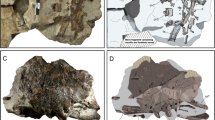Abstract
Although the image of crocodyliforms as ‘unchanged living fossils’ is naive, several morphological features of the group are thought to have varied only within narrow limits during the course of evolution1. These include an elongate snout with an array of conical teeth, a dorsoventrally flattened skull and a posteriorly positioned jaw articulation, which provides a powerful bite force. Here we report an exquisitely preserved specimen of a new taxon from the Late Cretaceous of Madagascar that deviates profoundly from this Bauplan, possessing an extremely blunt snout, a tall, rounded skull, an anteriorly shifted jaw joint and clove-shaped, multicusped teeth reminiscent of those of some ornithischian dinosaurs. This last feature implies that the diet of the new taxon may have been predominantly if not exclusively herbivorous. A close relationship with notosuchid crocodyliforms, particularly Uruguaysuchus (Late Cretaceous, Uruguay)2 is suggested by several shared derived features; this supports a biogeographical hypothesis that Madagascar and South America were linked during the Late Cretaceous3 .


Similar content being viewed by others
References
Langston, W. in Biology of the Reptilia Vol. 4 (eds Gans, C. & Parsons, T. S.) 263–284 (Academic, New York, 1973).
Rusconi, C. Sobre reptiles cretáceos del Uruguay (Uruguaysuchus Aznarezi, n. g. n. sp.) y sus relaciones con los notossúquidos de Patagonia. Bol. Inst. Geolog. Perf. Uruguay 19, 3– 64 (1932).
Krause, D. W. et al. The Late Cretaceous vertebrate fauna of Madagascar: implications for Gondwanan paleobiogeography. GSA Today 9, 1–7 (1999).
Brochu, C. A. Closure of neurocentral sutures during crocodilian ontogeny: implications for maturity assessment in fossil archosaurs. J. Vertebr. Paleontol. 16, 49–62 ( 1996).
Pol, D. Basal mesoeucrocodylian relationships: new clues to old conflicts. J. Vertebr. Paleontol. 19 (suppl. 3), 69A ( 1999).
Bonaparte, J. F. Los vertebrados fosiles de la Formacion Rio Colorado, de la ciudad de Neuquen y Cercanias, Cretacico Superior, Argentina. Rev. Mus. Argent. Cienc. Nat. 4, 16–123 ( 1991).
Clark, J. M., Jacobs, L. L. & Downs, W. R. Mammal-like dentition in a Mesozoic crocodylian. Science 244, 1064–1066 (1989).
Gomani, E. M. A crocodyliform from the Early Cretaceous dinosaur beds, northern Malawi. J. Vertebr. Paleontol. 17, 280– 294 (1997).
Medem, F. Osteología craneal, distribución geográfica y ecología de Melanosuchus niger (Spix) (Crocodylia, Alligatoridae). Rev. Acad. Colomb. Cienc. Exact. Fís. y Nat. 12, 5–19 (1963).
Balouet, J. C. & Buffetaut, E. Mekosuchus inexpectatus, n.g., n.sp., crocodilien nouveau de l’Holocene de Nouvelle Calédonie. C. R. Acad. Sci. 304, 853–856 (1987).
Willis, P. M. A. New crocodilians from the Late Oligocene White Hunter Site, Riversleigh, northwestern Queensland. Mem. Qld. Mus. 41, 423–438 (1997).
Carvalho, I. S. & Campos, D. A. Um mamífero triconodonte do Cretáceo Inferior do Maranhào, Brasil. An. Acad. Bras. Cienc. 60, 437–446 (1988).
Carvalho, I. S. Candidodon: um crocodilo com heterodontia (Notosuchia, Cretáceo Inferior – Brasil). An. Acad. Bras. Cienc. 66 , 331–345 (1994).
Wu, X. -C., Sues, H. -D. & Sun, A. A plant-eating crocodyliform reptile from the Cretaceous of China. Nature 376, 678– 680 (1995).
Benton, M. J. & Clark, J. M. in The Phylogeny and Classification of the Tetrapods Vol. 1 (ed. Benton, M. J.) 295– 338 (Clarendon, Oxford, 1988).
Krause, D. W., Prasad, G. V. R., Koenigswald, W. von, Sahni, A. & Grine, F. E. Cosmopolitanism among Gondwanan Late Cretaceous mammals. Nature 390, 504 –507 (1997).
Sampson, S. D. et al. Predatory dinosaur remains from Madagascar: implications for the Cretaceous biogeography of Gondwana. Science 280 , 1048–1051 (1998).
Buckley, G. A., Brochu, C. A. & Krause, D. W. Hyperdiversity and the paleobiogeographic origins of the Late Cretaceous crocodyliforms of Madagascar. J. Vertebr. Paleontol. 17 (suppl. 3), 35A ( 1997).
Iordansky, N. N. in Biology of the Reptilia Vol. 4 (eds Gans, C. & Parsons, T. S.) 201-262 (Academic, New York, 1973 ).
Gans, C. Biomechanics: An Approach to Vertebrate Biology (J. B. Lippincott, Philadelphia, 1974).
Wake, M. H. in The Skull Vol. 3 (eds Hanken, J. & Hall, B. K.) 197–240 (University of Chicago, Chicago, 1993).
Schumacher, G.-H. in Biology of the Reptilia Vol. 4 (eds Gans, C. & Parsons, T. S.) 101–199 (Academic, New York, 1973).
Hotton, N. III A survey of adaptive relationships of dentition to diet in the North American Iguanidae. Am. Midl. Nat. 53, 88– 114 (1955).
Sues, H.-D. & Reisz, R. R. Origins and early evolution of herbivory in tetrapods. Trends Ecol. Evol. 13, 141–145 (1998).
Galton, P. M. in The Dinosauria (eds Weishampel, D. B., Dodson, P. & Osmólska, H.) 456–483 (Univ. California, Berkeley, 1990).
Coombs, W. P. & Maryanska, T. in The Dinosauria (eds Weishampel, D. B., Dodson, P. & Osmólska, H.) 456–483 (Univ. California, Berkeley, 1990).
Swofford, D. L. PAUP*: Phylogenetic Analysis Using Parsimony (*and Other Methods), Version 4.0b2a. (Sinauer Associates, Sunderland, Massachusetts, 1999 ).
Acknowledgements
We thank B. Rakotosamimanana, A. Rasoamiaramanana, P. Wright, B. Andriamihaja, the staff of the Institute for the Conservation of Tropical Environments, the villagers of Berivotra, and all expedition members for assistance with field work; V. Heisey and J. Holstein for assistance with specimen preparation; B. Demes, C. Forster, N. Rybczynski and S. Zehr for discussion; and the NSF for funding.
Author information
Authors and Affiliations
Supplementary information
Rights and permissions
About this article
Cite this article
Buckley, G., Brochu, C., Krause, D. et al. A pug-nosed crocodyliform from the Late Cretaceous of Madagascar. Nature 405, 941–944 (2000). https://doi.org/10.1038/35016061
Received:
Accepted:
Issue Date:
DOI: https://doi.org/10.1038/35016061
- Springer Nature Limited
This article is cited by
-
A new short-faced archosauriform from the Upper Triassic Placerias/Downs’ quarry complex, Arizona, USA, expands the morphological diversity of the Triassic archosauriform radiation
The Science of Nature (2021)
-
Evolutionary structure and timing of major habitat shifts in Crocodylomorpha
Scientific Reports (2019)
-
First cranial remains of a gondwanatherian mammal reveal remarkable mosaicism
Nature (2014)
-
The evolution of mammal-like crocodyliforms in the Cretaceous Period of Gondwana
Nature (2010)
-
Stegosauria: a historical review of the body fossil record and phylogenetic relationships
Swiss Journal of Geosciences (2010)





